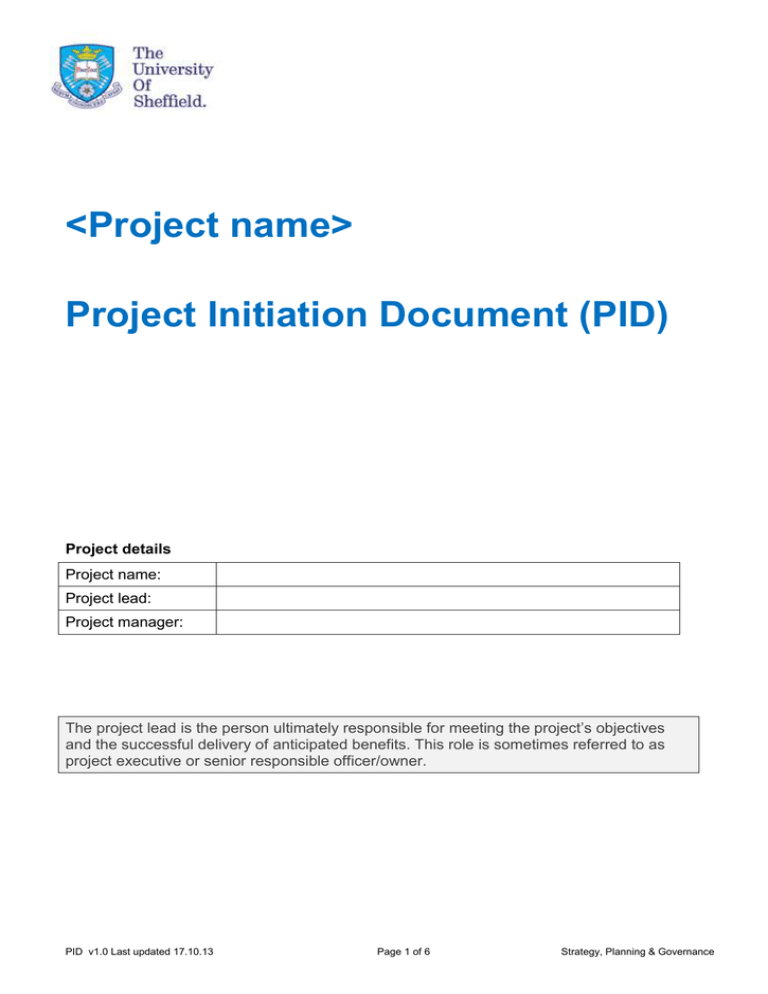<Project name> Project Initiation Document (PID)
advertisement

<Project name> Project Initiation Document (PID) Project details Project name: Project lead: Project manager: The project lead is the person ultimately responsible for meeting the project’s objectives and the successful delivery of anticipated benefits. This role is sometimes referred to as project executive or senior responsible officer/owner. PID v1.0 Last updated 17.10.13 Page 1 of 6 Strategy, Planning & Governance Document details Status Document (draft or version approved) Date Author and role Details of major changes Approved by Purpose of the Project Initiation Document (PID) The PID provides the main description of the project and is completed at the start of the project. The Project Manager is responsible for compiling the document, agreeing the contents with the Project Executive and other interested parties, and then taking it to the appropriate project governance group for approval to begin detailed planning. The PID should be concise but provide enough information to make a rational decision about whether this is a viable and worthwhile project, judged by looking at the balance between cost/benefit/risk, an assessment of whether the project can deliver the outputs detailed, and whether these outputs can deliver the benefits required. It provides a foundation for more detailed planning. The document will establish the terms of reference for the project and start to highlight potential risks. It is a key discussion document that is used to inform stakeholders about the aims of the project, establish their buy-in and develop their engagement. If external suppliers are to provide expertise, the PID can be used to define the requirements for their services. The PID should be maintained as a live document, updated and re-circulated to the project team Throughout this document guidance is provided in grey. On completion, these grey boxes can be deleted or they can be retained as a guide for readers. Please contact the Projects and Change team within Strategy, Planning & Governance for guidance projects@sheffield.ac.uk . PID v1.0 Last updated 17.10.13 Page 2 of 6 Strategy, Planning & Governance Project Initiation Document 1.1 Project driver What is the trigger for the project to be initiated? This could be a directive from senior management, a change in legislation/regulations, or a problem/ need or opportunity to be addressed. Ideally this should link with the University’s strategic objectives www.shef.ac.uk/ourplan . <Enter text here …> 1.2 Project Aims and Objectives What is the overall purpose (the aim), and the objectives, of the project? Objectives should be SMART – specific, measurable, achievable, relevant and timely. Aim <Enter text here …> Objectives <Enter text here …> 1.3 Project Scope What are the boundaries of the project? For instance which people, processes or systems will be included? Make the exclusions clear too – who/what will NOT be affected. In scope <Enter text here …> Out of scope <Enter text here …> 1.4 Project Deliverables and Outcomes/Benefits What will the project deliver (the output(s))? What will be the outcome(s)? What are the planned benefits? How will we know the project has been successful? Benefits derive from the project outcomes and should be tangible and measurable. Benefits are often realised once the project has been implemented. Deliverable Eg Revised and documented recruitment process PID v1.0 Last updated 17.10.13 Outcome Eg A process that reflects best practice, complies with new legislation, improves the speed of recruitment and reduces recruitment costs. Page 3 of 6 Benefit Eg A 20% reduction in recruitment costs in year 1, recruitment time from advert to offer improved by 25% in first 6 months, process benchmarked against industry best practice, no legal challenges to recruitment practices. Strategy, Planning & Governance 1.5 Project Approach This describes how the project will be run. If there are a number of ways in which the project can be approached, provide the key options being considered early in the project, eg how will the project objectives be delivered? All will have pros and cons so these should be captured too. What is the preferred approach, and why? If the project is to be split into workstreams, you could detail these here. <Enter text here …> 1.6 Key Milestones State the Project’s key milestones or target dates in the table below. Milestones are points in time so the language used to describe them should indicate this (eg. “Software development complete” rather than “Develop software”). Include the target milestone dates for gaining approval to plan and approval to deliver, and a project finish date. Ref. Milestone Description Planned date 1 2 3 4 1.7 Project Team and Governance In this section you show how the project team will be organised. You should insert the key roles, as far as they are known in the early stage of the project. You may need to update this section during detailed planning. Indicate any anticipated people resources. Try and estimate length of involvement in the project, as well as estimate of time involved (eg 2 hours per week for six months). Early discussion of resource needs/availability should take place with the line manager of the resources identified. Any issues around availability and suitability of resources should be documented below the table. You could also enter frequency of project board meetings or reporting requirements in this section. Project Team Names Eg Mark Brown Role Key Time Estimate responsibility/accountability Project Sponsor This is typically a UEB member or senior manager Project Lead PID v1.0 Last updated 17.10.13 Page 4 of 6 Strategy, Planning & Governance The person ultimately responsible for the successful Project Manager Project Board Members Project Team members 1.8 Summary of Risks You should include a section on key risks (those that are likely to have a medium/high probability and impact). These will be updated regularly during the life of the project, usually in a separate risk register. A risk is an uncertain event that, should it occur, will have an effect on the achievement of objectives. If you are considering different approaches, fill out a risk table for each option. No. Risk Comments 1 Eg Data for analysis not available in the required format What is the risk of NOT proceeding with the project? <Enter text here …> 1.9 Costs Indicative costs (if any) for the project. This could include spend on additional resources, external suppliers or systems. <Enter text here …> 1.10 Project Interfaces and Dependencies This covers the known interfaces and dependencies relating to the project such as the activities of other projects, teams or organisations. Dependencies may be: incoming (where this project is dependent on something happening elsewhere) outgoing (where another project is dependent on a task/milestone here). Note this does not include dependencies within the project (i.e. task A cannot commence until task B has finished) as these will be captured in the project plan. PID v1.0 Last updated 17.10.13 Page 5 of 6 Strategy, Planning & Governance <Enter text here …> 1.11 Stakeholders Identify key stakeholders – people or groups who may be affected by or interested in the development of the project. <Enter text here …> PID v1.0 Last updated 17.10.13 Page 6 of 6 Strategy, Planning & Governance





